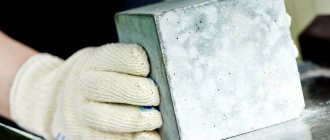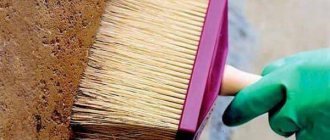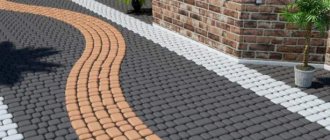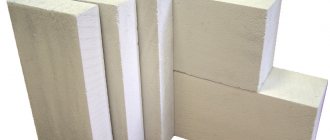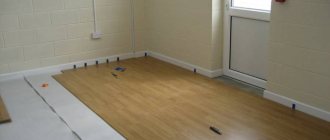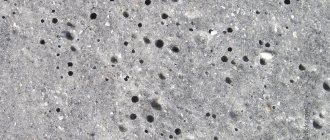It is mandatory to check the quality of the material used during the installation of buildings and structures. To confirm compliance of the declared characteristics with design standards, concrete is tested for strength, bending and tensile strength. This measure allows the contractor to report to the customer on the work carried out in accordance with the project, and the manufacturer to confirm the quality of the products. Timely tests will allow you to make changes to the progress of work and avoid mistakes.
Tests are carried out in certified laboratories based on GOST 22690-2015, for which specialists use various methods of measuring and influencing selected material samples. They usually use concrete cubes that are tested under compression, but there are other research methods.
During the test, the following results are obtained:
- Determine the compliance of the quality of the material with the design documents. Tests are carried out at least three times during the entire construction period.
- If the characteristics deviate, structures made from rejected material are replaced, which allows the overall performance of the structure to be maintained within the project.
- Preliminary tests are mandatory when carrying out repair work in technical rooms and basements.
- Testing of reinforced concrete structures makes it possible to make decisions about the fate of old buildings and structures.
What does the strength of concrete depend on and what influences it?
The ability of concrete to resist external influences due to internal stress depends on the composition of the solution and the brand of cement. When confirming the strength of a material corresponding to a certain brand, the sample should not show signs of destruction in the form of chips, cracks, or delamination of the structure.
Sometimes builders, when carrying out work, try to save on materials by using cheaper, low-grade concrete, but violating the design values can lead to serious consequences, so such a means of saving is unacceptable.
In addition to the ratio of filler and cement, the strength of the composition is influenced by additives and plasticizers used to give the product special properties (acid resistance, water resistance, speed of rise, plasticity). To obtain structures that can withstand high loads, it is mandatory to reinforce the elements with metal wire of various sections.
In addition to the composition of the solution, the strength of concrete is influenced by the external conditions under which the pouring is carried out. With high-quality removal of air bubbles from the concrete mass by compacting the mixture, the strength of the products increases noticeably.
It should also be taken into account that when using a solution at subzero temperatures, measures should be taken to heat the material by installing electrodes in the fill and connecting electricity to them. In such a situation, covering the base with sawdust is also used.
When working with concrete, it is important to maintain the necessary humidity to prevent cracking of the pouring surface due to rapid evaporation of moisture, which also affects the quality of the material and its strength. To avoid this process, it is necessary to cover the concrete with film or other available means, and also periodically moisten the surface.
As a result, it can be argued that the strength of concrete depends on many factors, and therefore quality control is especially important when installing load-bearing structures, since even if the technological processes are fully followed, there can always be factors that will affect the concrete and cause problems in the future .
Types of concrete examination
The laboratory conducts several types of independent examinations of concrete:
- Definition of workability. This is the ability of concrete to fill a form prepared for it under its own weight or under the influence of external factors.
- Determination of density. This indicator is necessary for calculating the load on building structures.
- Determination of abrasion. This indicator reflects the ability of a material to change volume and mass under the influence of abrasive forces. The harder the material is, the lower its abrasion resistance.
- Determination of strength. The strength of concrete directly affects the ability of products and structures to withstand loads during operation.
- Definition of shrinkage. This characteristic displays how much the volume of the concrete mixture decreases over the period allotted for the set of strength characteristics.
- Determination of frost resistance. Frost resistance of concrete is responsible for the ability of the material to maintain a given strength after freezing and subsequent thawing.
Classification of test methods
Several methods are used to test concrete:
- Testing of samples cast in laboratory conditions. This method involves the production of cubes or cylinders from the test mixture, followed by testing the strength of the material on a press;
- Checking samples cut or cut from a finished structure. Such samples are obtained by drilling with diamond bits. Next, the resulting cores are sent to the laboratory to determine the strength characteristics, as in the first case, using a press. This method is associated with significant costs in obtaining the sample and with the threat of weakening the integrity of the element from which the core was obtained;
- A method for testing concrete for strength using a non-destructive method. In this case, tools and devices are used with which you can study the characteristics of concrete without placing samples in special devices. For these studies, ultrasound can be used, the quality of the base can be checked using the shock-impulse concrete testing method, etc.
The most popular method, which allows one to obtain the most accurate indicators of the properties of concrete, is testing samples for compression under pressure.
Acceptable options for control samples.
Test stages
Concrete testing is carried out by examining samples for strength using non-destructive and destructive methods.
Destructive methods
This method involves testing using a press, when gradually increasing pressure is applied to a sample obtained during laboratory casting or cut from the base of a finished structure. The impact continues until the destruction of the sample is detected.
This method is the most accurate and mandatory when carrying out work on the construction of critical structures.
Non-destructive methods
To obtain results when using non-destructive testing methods, special instruments and devices are used. Partial destruction is carried out by fixing a special tool on the concrete surface, which allows you to examine the concrete for tearing, recording the required force.
The reaction of the material to shearing is also studied when the device is installed on the corner of a concrete base and the material is destroyed under load.
Separation with chipping.
Under shock loads, the behavior of concrete during impact is studied with a special device and the reaction to elastic rebound is recorded - the value of the rebound of a metal ball released with a certain force is measured.
During ultrasonic quality control of concrete, a special device is used that makes it possible to record the passage of waves inside the structure. Based on the reaction to reflection, a conclusion is drawn about the quality of the material.
Sclerometer.
How to test the strength of concrete yourself? It is impossible to obtain a complete study of the material at home. Quality control of the material can be done exclusively by visual methods. A high-quality mixture usually has a gray or gray-green color; the structure of the solution should be uniform, with normal viscosity.
If the material has a yellowish tint, this means that the quality of such a solution is low and its composition contains impurities that reduce the strength characteristics. A good sign is the discovery of a thick consistency of cement laitance on the surface of the solution.
Under impact loads (hitting a material that has gained full strength with a hammer), the tool should bounce off the base without significant changes on the surface, leaving almost invisible dents.
Laboratory testing of working solution
Laboratory
Control begins from the moment of its preparation.
Note! The frequency and volume of sampling for further testing depends on the type of structure being manufactured, compaction, exposure, driving method, and many other factors. But at least once during the manufacture of one batch of products. The technologist and the head of the laboratory establish internal regulations and procedures in accordance with which sampling is carried out.
When producing prestressed reinforced concrete products, it is necessary to make samples for each pour in order to establish the time of destressing of the product using laboratory control.
Depending on the type of production and manufactured products, there are different selection rules:
- In the production of ready-mixed concrete, fences are made directly from the batching unit during the shipment of the solution.
- In factories during the production of prefabricated reinforced concrete, it is allowed to take the working mixture directly from the mixer, during dispensing, or from a bucket.
Note: Ideally, samples should be taken from three stages of production. But sometimes, in large enterprises where all work processes are automated, getting to the BSU for sampling is not so easy. Therefore, samples are taken from three average batches during distribution or molding.
- In the production of monolithic reinforced concrete, selection is carried out when laying the mixture. Already compacted material will not give reliable results, so it is best to take the solution from the next batch.
Sampling
The volume of material selected for the production of control samples must be within officially established limits:
- when manufacturing products with a volume of more than 2 m3, more than three series of samples are required;
- one series of samples for the volume sold to the consumer - there should not be more than 50 m3 of samples from one brand;
- in the manufacture of monolithic structures, depending on the volume of products produced, there must be at least one series of samples per product.
If the material is produced at a construction site, it is collected into an ordinary tin bucket (or buckets) and taken to the laboratory urgently - until the cement laitance appears on the surface. According to the rules, of course, it is necessary for a mobile laboratory to come to the site - but what is not there is not there. Especially in small towns.
When sampling has been carried out, the first control measures can begin.
Determination of workability
Supplying the mixture to the formwork
Not only in laboratories, but also on construction sites, tests are carried out for workability and rigidity. The data obtained gives digital values in centimeters, which can be classified and a grade assigned to the prepared material according to its mobility.
The process is not complicated and training as a laboratory assistant is not required. You just need to have certain knowledge, which we will share.
Cone for definition
To do this, according to GOST 10181−2014, you will need:
- Special conical shape with stops. You can make it yourself, following the exact recommendations of the standard. But you can take a simpler route and purchase it in specialized stores. The price for it is not that high.
- Two steel, preferably verified rulers.
- Trowel.
- Construction funnel.
- Metal rod.
Stages of work:
Stages of events
- Stage 1. The mixture is applied into the cone using a funnel until it is completely filled, and thoroughly bayoneted 25 times along the entire length and area of the lower layer.
- Stage 2. Remove the funnel and carefully remove the excess mixture with a ruler.
- Stage 3. With a gentle movement, lift the cone strictly horizontally and place it next to the material.
- Stage 4 . Concrete begins to settle under its own weight. This process does not need to be hindered. And as soon as it ends, continue the event.
- Step 5. Place a ruler on the top of the cone so that the difference in height between the sample and the cone can be measured. Measurements are carried out with an accuracy of millimeters.
Measuring OK using a ruler
- Step 6. A similar process is repeated twice, and the last value is taken as the arithmetic mean between the two. If the results differ too much - more than 2 cm, then the event is repeated with a new sample.
- Stage 7. The resulting value in centimeters is the mobility of the mixture.
Depending on it, mixtures are:
- flowing (cast) – OK from 21 cm;
- mobile - OK 10–16 cm;
- moderately mobile - OK 6–9 cm;
- sedentary - OK 1–5 cm;
- moderately hard, hard, extremely hard and especially hard mixtures - OK 0 cm.
But mobility has its own alphanumeric designation P:
- P1 – 1-4 cm;
- P2 – 5-9 cm;
- P3 –10-15 cm;
- P4 –16-20 cm;
- P5 – 21 cm and more.
Knowing these values, you can adjust the composition if they do not correspond to the design ones - for example, increase plasticity by adding a plasticizer.
Sample molding
When control of the mixture is completed, you can begin molding into standard metal molds measuring 10*10 cm in order to carry out further activities. In this case, the use of material that has been tested for workability is not taken for molding cubes. A fresh sample is needed.
Tensile test procedure
To perform tensile tests, you will need to prepare a sample of an elongated prism-type shape. This sample is placed in a special device in a horizontal position, then a force is applied to the middle of the sample with increasing load. The step of the impact on the sample is 0.5 MPa/s.
The result is recorded after the destruction of the concrete structure in the central part of the sample.
Compression test procedure
This test method allows you to determine the grade of the material. To carry out the test, cubes are cast from concrete used in construction, or samples are cut out from an already cast product. The size of concrete testing cubes varies from 100 to 300 mm along the edge. In addition to the cubic shape, samples can be made in the form of cylinders or prisms.
When casting samples in laboratory conditions, a vibrating table is used to ensure that the mixture obtains maximum density. Tests are carried out on days 3, 7 and 28 after the sample acquires strength. The main tests are carried out on the 28th day after the material has fully gained strength.
The sample is placed under a press, which presses on the cube with a power of 140 kgf/m2 in increments of 3.5 kgf/m2. The force vector is strictly perpendicular to the base of the sample. Based on the readings, the material’s ability to resist compression is determined, and the grade of concrete is recorded in the test report.
Sample test report.
Gostov tests of concrete samples
Molded samples
According to GOST 10180−2012, after concrete samples have been kept in molds for about a day from the moment of molding, the formwork can be removed and put into a room for further curing in special humid conditions.
But this does not apply to samples taken during the molding of prestressed products. They are kept under similar conditions as the product - heat and humidity treatment or natural hardening.
To find out whether the material has reached the required percentage of stress relief strength - this is approximately 75% of the design value - three samples must be stripped after the intended processing period and sent for control. Remove the remaining ones for aging for 7 and 28 days.
Compression test
Press
Strength control is the main thing to determine its quality. It is used to decide whether the product can be released to the consumer, or whether it can be allowed to mature. Samples from the same collection are tested twice - at seven days of age and at twenty-eight days of age.
Attention! During the first inspection, the material must gain at least 70% of the design strength. Otherwise, he is not released from the plant for further activities.
The equipment is simple:
- press;
- certified scales;
- certified metal ruler.
For compression, control measures are carried out in accordance with GOST 10180−2012 as follows:
- Stage 1. Prepare the cubes.
- Step 2: Each sample is weighed and measured. If there is a large deviation in the parameters, the cube is considered unsuitable for control.
- Stage 3. The sample is installed on the prepared press in such a way that the edges in contact with the press are smooth and do not represent the molding side. She begins to collapse first.
Conducting a compression test
- Stage 4. The limiting load is considered to be at which complete destruction of the sample occurs. Modern presses display this limit value and store it in their memory.
Protocol
- Stage 5. After checking all the images, the arithmetic mean is taken and accepted as the final result, which is entered into the act. After all the actions have been carried out, a certificate is issued based on them, which shows the true quality of the manufactured products and designs.
Tensile test
Tension check
Monitoring for susceptibility to stretching is carried out less frequently. The obtained values help to find out the maximum axial tensile load that a particular product can withstand.
In this case, the cubes are not tested, but samples made in the form of beams are subjected to load.
It looks like this:
- Stage 1. Installation of hinge supports on the press plate.
- Stage 2. The sample is installed on supports at a test span distance from the top plate of the press, which is equal to three times the cross-sectional size of the sample.
- Stage 3. Hinged supports are installed on the prism, and a special traverse is installed on them, and the press is launched.
Work process
- Stage 4. The value is taken as the average of all samples in which destruction occurred in the middle third of the prism. When testing samples with dimensions of 200x200x800 mm and 150x150x600 mm, the resulting strength is multiplied by a factor of 0.1, and for samples of 100x100x400 mm by 0.95. The resulting values are recorded in the protocol.
Concrete strength grades and their scope of application
To determine the characteristics of concrete, it is given a marking according to GOST: the letter M and a number indicating the compressive strength of the material. The higher the value, the more durable the product made from this material is - the strength depends on the amount of cement in the mixture.
According to its strength characteristics, concrete is divided into grades from M100 to M500 in increments of 50. Another characteristic, the concrete class, determines the ability of the material to work in aggressive environments.
Concrete grades M100, M150, M200 and M250 are classified as light and cellular. They are used for pouring structures that do not bear a significant load. They are used for constructing curbs, foundations for small buildings, and pedestrian paths.
Concrete M300 and M350 can be used for casting floor slabs, constructing foundations in multi-story construction, and casting monolithic walls.
The most durable concrete grades, M400, M450 and M500, are used in the production of reinforced concrete structures operating in difficult conditions with increased load (for example, for the construction of hydraulic structures).
